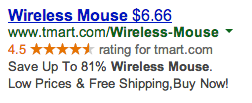If you’ve been in the web industry less than 10 years, you don’t realize you’ve been standing on the shoulders of giants. It’s commonplace for those in digital media to disparage print advertising like Yellow Pages. But were it not for countless media studies conducted over the years, we’d have no clue how to make an effective ad. Each year, the Yellow Page industry commissions a Metered Ad Study. Third-party media research firms place call-tracking phone numbers on nearly 200,000 display ads. This measures ad performance metrics like average number of calls, cost per lead, and return on investment. The study reveals an interesting phenomenon. Often, two ads of the same size, both placed in the same heading, will get radically different call counts. When one ad gets 87 calls a month and another ad gets 22 — researchers want to know why. They found that ads under-perform when they lack information consumers need to make a buying decision. The Yellow Page industry used this data to develop a list of six factors that every ad should include. These work because Yellow Page users are further along in the decision-making process. But unlike Yellow Pages, the Internet allows people to conduct research as part of the buying process. So to create ads that people want to click, your ad must first be relevant.
Creating Relevant Ads
In 1999, the best-designed minivan ad could not have enticed me to buy one. But in 2000, my family grew by one and minivans became relevant to my needs. Suddenly, minivan ads were everywhere.
The company arrived [in China] in 2006 armed with its popular slogan: “You can do it. We can help.” But cultural studies have shown that most people in China don’t want to do it themselves. They want someone to do it for them.Six years later, Home Depot closed all its stores in China. As Home Depot CEO Frank Blake later told Fortune, “In China, doing it yourself is not a point of pride.” Oops. Make sure to present the right message to the right customer. People don’t read ads; they read what interests them. Before you consider placing an ad buy (or going to China), identify your target audience.
Usability
Usability includes readability, design elements, and effective ad copy (e.g., compelling headlines and call to action). Let’s talk about each.Headlines in PPC ads
 If I’m searching for a personal injury attorney because I’ve been hurt in a car accident, then Hurt in a Car? will capture my attention far better than Smith and Jones, Attorney-at-Law.
In advertising, the headline is the single, most important element of your ad copy. With pay-per-click advertising, the headline is one of three available lines. So make it count.
One way to make PPC headlines more effective is Dynamic Keyword Insertion. This causes your headline and ad copy to match the search query. (Notice that my search query business cards online appears in both.)
If I’m searching for a personal injury attorney because I’ve been hurt in a car accident, then Hurt in a Car? will capture my attention far better than Smith and Jones, Attorney-at-Law.
In advertising, the headline is the single, most important element of your ad copy. With pay-per-click advertising, the headline is one of three available lines. So make it count.
One way to make PPC headlines more effective is Dynamic Keyword Insertion. This causes your headline and ad copy to match the search query. (Notice that my search query business cards online appears in both.)
Headlines in Display Ads
In display ads, your headline is not the most important element in your ad copy. It’s the only element in your ad copy. Search advertising targets buyers who are looking for a seller. But consumers who see your display ad are consuming content rather than searching for your product or service. That means you must draw your consumer’s attention away from what they’re reading. So your display ad must combine a strong headline statement and appealing graphics.Design Elements in Display Ads
With outdoor advertising, you have three seconds to capture the consumer’s attention. So take a page from basic rules of billboards design:- Short copy
- One offer
- Clear graphic
- Readable typeface
- Show it, don’t say it
- The more impressions, the better
 But outdoor advertising is not a direct response medium. So be sure to include a call to action in your display ad.
Like commuters traveling at 60 mph, web surfers are not looking for your product or service the moment they see your ad. This is why display advertising has a low CTR (.05%). It’s better suited for branding and exposure than generating immediate leads or sales.
That said, research suggests that display advertising can increase the effectiveness of your search ads:
But outdoor advertising is not a direct response medium. So be sure to include a call to action in your display ad.
Like commuters traveling at 60 mph, web surfers are not looking for your product or service the moment they see your ad. This is why display advertising has a low CTR (.05%). It’s better suited for branding and exposure than generating immediate leads or sales.
That said, research suggests that display advertising can increase the effectiveness of your search ads:
We consistently see SEM (search engine marketing) spike when a banner buy is in market. Clearly banners have a demonstrable effect on awareness even if they don’t generate an immediate click.Uncovered in the ruins of ancient Rome and Pompeii were signs advertising taverns, gladiatorial games and property for rent. While they couldn’t measure impressions and CTR back then, the principles of effective ad design are almost as ancient. Deliver the right message to the right customer at the right time. It worked for the Yellow Pages and in Ancient Rome. It can work for you, too.
Frequently Asked Questions (FAQs) about Creating Ads People Want to Click
What are the key elements of an effective ad?
An effective ad should have a clear message, a compelling offer, and a strong call-to-action. It should be visually appealing and should resonate with the target audience. The ad should also be consistent with your brand image and values. It’s important to test different versions of your ad to see which one performs the best.
How can I make my ad stand out from the competition?
To make your ad stand out, you need to understand your audience and what they value. Use this information to create an ad that speaks directly to their needs and desires. Use compelling visuals and strong headlines to grab their attention. Also, consider using a unique selling proposition (USP) that differentiates your product or service from the competition.
How can I increase the click-through rate (CTR) of my ads?
Increasing the CTR of your ads can be achieved by improving the relevance of your ads, using compelling headlines, and including a strong call-to-action. It’s also important to target your ads to the right audience. Use A/B testing to find out which version of your ad gets the most clicks.
What is A/B testing and how can it improve my ads?
A/B testing is a method of comparing two versions of an ad to see which one performs better. By changing one element at a time (such as the headline, image, or call-to-action), you can determine which version is more effective. This can help you optimize your ads and increase their performance.
How can I track the performance of my ads?
You can track the performance of your ads using various metrics such as click-through rate (CTR), conversion rate, and return on ad spend (ROAS). These metrics can provide valuable insights into how well your ads are performing and where improvements can be made.
What are some common mistakes to avoid when creating ads?
Some common mistakes to avoid include using too much text, not having a clear call-to-action, and not testing different versions of your ad. It’s also important to avoid making false or misleading claims in your ads, as this can damage your brand reputation.
How can I create ads that resonate with my target audience?
To create ads that resonate with your target audience, you need to understand their needs, desires, and pain points. Use this information to create ads that speak directly to these factors. Use language and visuals that your audience can relate to.
How can I use social media to enhance my ad campaigns?
Social media can be a powerful tool for enhancing your ad campaigns. You can use social media to target specific demographics, engage with your audience, and increase brand awareness. You can also use social media analytics to track the performance of your ads and make necessary adjustments.
What is the role of visuals in creating effective ads?
Visuals play a crucial role in creating effective ads. They can grab the viewer’s attention, convey your message quickly, and evoke emotional responses. Using high-quality images, videos, and graphics can significantly improve the performance of your ads.
How can I create ads that are both engaging and informative?
Creating ads that are both engaging and informative requires a balance of creativity and strategic thinking. Use compelling visuals and headlines to grab the viewer’s attention, and then provide valuable information that addresses their needs or solves their problems. Always include a clear call-to-action that guides the viewer on what to do next.
 John Tabita
John TabitaFormer owner and partner of web firm Jenesis Technologies, John is currently Director of Digital Strategy at Haines Local Search, a company providing local search marketing solutions to SMBs, including print and Internet Yellow Pages, web design, and local SEO. When not working or spending time with his family, John offers great sales and marketing advice on his blog, Small Business Marketing Sucks. When not working or spending time with his family, John offers great sales and marketing advice on his blog, Small Business Marketing Sucks.
